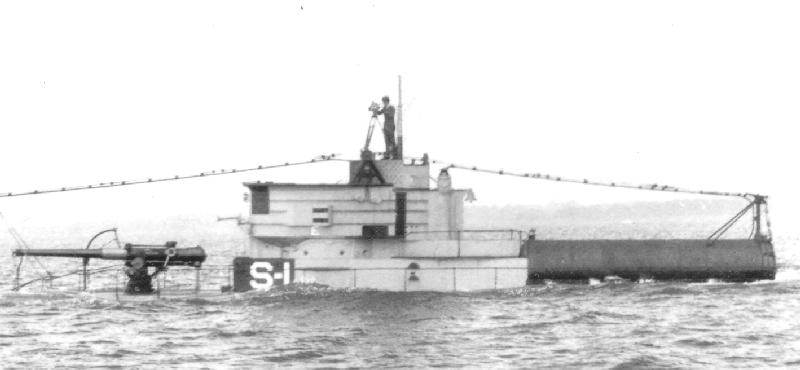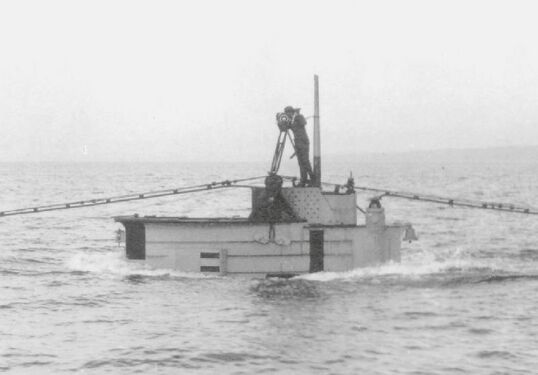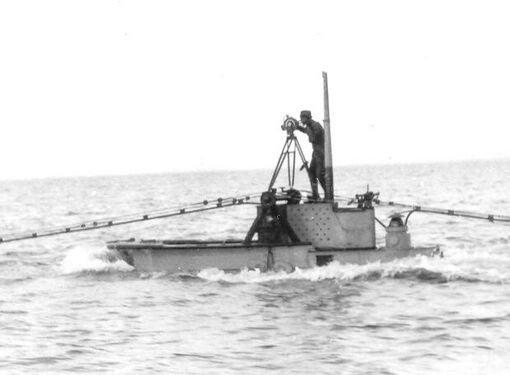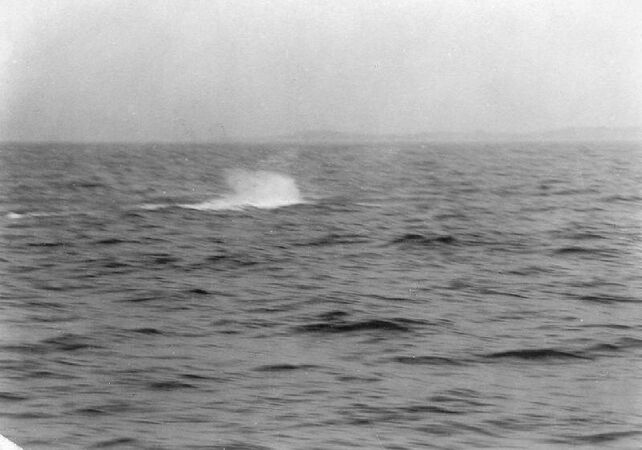S-1: Difference between revisions
Pbcjohnston (talk | contribs) Text updates |
Pbcjohnston (talk | contribs) |
||
| (12 intermediate revisions by the same user not shown) | |||
| Line 1: | Line 1: | ||
[[File:S- | [[File:New Header EB S-boats.jpg]] | ||
__TOC__ | |||
== <big>Construction, trials, and early service</big> == | |||
[[File:S-1 bow.jpg|left|500px]] | [[File:S-1 bow.jpg|left|500px]] | ||
| Line 19: | Line 23: | ||
<small>Photo provide by his grandniece, Patricia M. Lynn.</small> | <small>Photo provide by his grandniece, Patricia M. Lynn.</small> | ||
[[File:Red bar sub new.jpg]] | |||
<div style="text-align: justify;"><span style="color:#000000"> | |||
== <big>Aircraft operations conversion</big> == | |||
=== Notes === | |||
<div style="text-align: justify;"><span style="color:#00008B">The dates of the testing below are in doubt. Even though they were taken from official USN sources ([https://www.history.navy.mil/research/histories/ship-histories/danfs/s/s-1.html '''the Dictionary of American Naval Fighting Ships, aka DANFS''']), the webmasters are having a hard time believing that over 2½ years elapsed between the 1923 tests in Norfolk and the "first full cycle test" in 1926 in Groton. We believe that it is likely that the later date is in error, and the first full cycle test was actually sometime in 1924, vice 1926. It is possible that the dates are correct and that the Navy, for whatever reason, was just moving very slowly in the test series, but we find that unlikely. For now we will leave the dates as published, and if we find a correction we will publish it then. | |||
[[File:Red bar sub new.jpg]] | |||
[[File:O-8 and S-1.jpg|left|500px]] | |||
This photo shows the beginning of the conversion work done to S-1 so that she could carry out the Navy's first, and as it turned out only, tests with launching an airplane from a submarine This is at the Portsmouth Navy Yard, Kittery, Maine in the late spring of 1923. The photo shows S-1 alongside the work pier, with [[O-8|'''O-8''']] maneuvering into the berth to the left. S-1 has had her aft superstructure removed in preparation to have the watertight aircraft storage cylinder installed. Work is also being done to her forward superstructure to remove the original [https://pigboats.com/index.php?title=Gun_photos_%26_information#3%22/23_Mk_9 '''3"/23 caliber Mk 9 deck gun''']. In its place will be a foundation for and installation of a much more substantial [https://pigboats.com/index.php?title=Gun_photos_%26_information#4%22/50_Mark_12_Various_Mods '''4"/50 caliber Mk 12 Mod 6 gun''']. | |||
<small>NARA photo via Historylink101.com.</small> | |||
[[File:Red bar sub new.jpg]] | |||
<center> | |||
<gallery mode="packed" perrow=2 widths="400px" heights="300px"> | |||
File:S-1 stbd bow.jpg | |||
File:S-1 midships Oct 23.jpg | |||
File:S-1 stbd quarter.jpg | |||
File:S-1 plane 2.jpg | |||
</gallery> | |||
</center> | |||
<div style="text-align: justify;"><span style="color:#00008B">By the fall of 1923 the conversion work on S-1 was essentially complete and the Navy was eager to begin the initial aircraft testing. S-1 moved down to Naval Air Station Norfolk off Willoughby Bay in Norfolk, VA. There she conducted the earliest experiments with a floatplane on October 23, 1923. The plane would normally be stored in the hangar disassembled. It had to be pulled out and assembled, then the boat would submerge the after deck until it floated off. The pilot would then start the engine and make his take off run. After landing the process would be the reverse. From first breaking the surface to the airplane taking off took at least 30-40 minutes, and the process required a flat calm sea to do safely. | |||
Three different floatplanes were used in the tests. All three were based on a USN Bureau of Aeronautics design and thus were very similar, virtually identical, in appearance. Those types were:<br> | |||
*Cox-Klemin XS-1 - all wood frame with fabric covered fuselage and wings. Powered by a Lawrance L-4 engine. Six were built. | |||
*Cox-Klemin XS-2 - upgraded model with a Kinner B-5 engine. One built. | |||
*Martin MS-1 - License built version with an aluminum frame and fabric fuselage and wings. Six built. | |||
Note how much further down on the pressure hull the newly expanded aft superstructure extended, compared to the first photo above. | |||
In the fourth photo S-1 has flooded down her after ballast tanks, submerging her stern. Note the crewmen walking on her after deck, up to their ankles in water. It appears that S-1 is trying to recover the floatplane after a taxi or flight test. | |||
<small>U.S. Navy and NARA photos via NHHC and Historylink101.com.</small> | |||
[[File:Red bar sub new.jpg]] | |||
<center> | |||
<gallery mode="packed" perrow=2 widths="400px" heights="300px"> | |||
File:S-1 at Portsmouth stbd side Dec 22.jpg | |||
File:S-1 port midships Dec 22.jpg | |||
File:S-1 stbd midships Dec 22.jpg | |||
File:S-1 and hangar port side.jpg | |||
</gallery> | |||
</center> | |||
These four photos were taken in late 1923 into early 1924 at a cold and snowy Portsmouth Navy Yard and show overhaul work being conducted on the aircraft hangar, perhaps to correct problems revealed in the Norfolk tests. These photos give a good view of how the hangar was arranged. | |||
It was built out of 3/4 inch thick steel and was designed to withstand up to 88 lbs/sq in., or a depth of 197 feet (the test depth of an S-boat was 200 feet). It was 5 ft 9 inches (1.75 meters) in diameter. In case of flooding it was equipped with two separate drain lines and a 100 psi air blow line to empty it. The hemispherical door is hinged on the bottom and sealed to the cylinder by 11 individually bolted flanges. Once unbolted, the heavy door was lowered into a recess in the main deck (normally covered by a slotted deck hatch) using a chain fall attached to the stub mast directly above the door. The aircraft could then be pulled out and assembled for flight. | |||
It proved to take an undesirable amount of time to open the door due to the bolted flanges, and when combined with the time it took to assemble the plane, and with the limited tactical utility of the small and short ranged aircraft, the concept was evaluated as impractical and the testing ended without further development in the USN. | |||
Note the gunboat USS Wilmington (PG-8) moored in the background. | |||
<small>NARA photos via Historylink101.com.</small> | |||
[[File:Red bar sub new.jpg]] | [[File:Red bar sub new.jpg]] | ||
[[File:S-1 first airplane trial Sept-2-1926.jpg|left|500px]] | [[File:S-1 first airplane trial Sept-2-1926.jpg|left|500px]] | ||
Aircraft testing continued quite slowly between late 1923 and the spring of 1926. It was a conservative testing program, and it may have been slowed by budgetary concerns as well. The first full cycle of surfacing, assembly, launching, retrieving, disassembly, and submergence actually did not take place until July 28, 1926 on the Thames River at New London. | |||
Newspaper Photo Caption: ''THE FIRST SUBMARINE AIRPLANE IS TESTED OFF NEW LONDON<br>New London, Connecticut -- The United States Navy held the first tryout of the "Peanut Plane" off New London recently. It is a tiny three cylinder airplane installed in a waterproof casing on the deck of the U.S. submersible S-1 and can be launched in the short time of nine minutes. The plane weighs only 1000 pounds and is flown by the first "Submarine Pilot" LT Dolph C. Allen. Photo shows the plane completely assembled and ready for flight, which is launched by lowering the stern of the submarine. 9-2-26'' | Newspaper Photo Caption: ''THE FIRST SUBMARINE AIRPLANE IS TESTED OFF NEW LONDON<br>New London, Connecticut -- The United States Navy held the first tryout of the "Peanut Plane" off New London recently. It is a tiny three cylinder airplane installed in a waterproof casing on the deck of the U.S. submersible S-1 and can be launched in the short time of nine minutes. The plane weighs only 1000 pounds and is flown by the first "Submarine Pilot" LT Dolph C. Allen. Photo shows the plane completely assembled and ready for flight, which is launched by lowering the stern of the submarine. 9-2-26'' | ||
It should be noted that the launching time of nine minutes was an initial estimate only. In actual practice it turned out to be more like 30-40 minutes in calm weather and good conditions. | It should be noted that the launching time of nine minutes was an initial estimate only. In actual practice it turned out to be more like 30-40 minutes in calm weather and good conditions. | ||
<small>News photo in the private collection of Ric Hedman.</small> | <small>News photo in the private collection of Ric Hedman.</small> | ||
[[File:Red bar sub new.jpg]] | [[File:Red bar sub new.jpg]] | ||
[[File:S-1 surface 1.jpg|left|500px]] | |||
<div style="text-align: justify;"><span style="color:#00008B">S-1 surfacing after a dive in the Thames River, CT., July 22, 1926. | |||
<small>Photo in the private collection of Ric Hedman</small> | |||
< | |||
[[File:Red bar sub new.jpg]] | [[File:Red bar sub new.jpg]] | ||
[[File:S-1 | [[File:S-1 surface 2.jpg|left|500px]] | ||
<div style="text-align: justify;"><span style="color:#00008B"> | <div style="text-align: justify;"><span style="color:#00008B">This photo was taken shortly after the one above, with the S-1's forward deck completely clear of the water, but with the after deck still submerged. | ||
<small> | <small>Photo in the private collection of Ric Hedman</small> | ||
[[File:Red bar sub new.jpg]] | [[File:Red bar sub new.jpg]] | ||
[[File:S-1 port 2.jpg|left|500px]] | [[File:S-1 port 2.jpg|left|500px]] | ||
<div style="text-align: justify;"><span style="color:#00008B">S-1 underway for a photo opportunity | <div style="text-align: justify;"><span style="color:#00008B">S-1 underway for a photo opportunity in the Thames River near New London, CT. July 1926. | ||
<small>Photo in the private collection of Ric Hedman.</small> | <small>Photo in the private collection of Ric Hedman.</small> | ||
| Line 63: | Line 125: | ||
[[File:Red bar sub new.jpg]] | [[File:Red bar sub new.jpg]] | ||
<center> | |||
<gallery mode="packed" widths="350px" heights="250px"> | <gallery mode="packed" widths="350px" heights="250px"> | ||
File:S-1 diving 4.jpg | File:S-1 diving 4.jpg | ||
| Line 70: | Line 133: | ||
</gallery> | </gallery> | ||
</center> | </center> | ||
<div style="text-align: justify;"><span style="color:#00008B">A series of four photos that show S-1 diving with a very brave camera man on top of the periscope shears! Location is unknown, but the date is approximately | <div style="text-align: justify;"><span style="color:#00008B">A series of four photos that show S-1 diving with a very brave camera man on top of the periscope shears! Location is unknown, but the date is approximately 1926. | ||
<small>Photos in the private collection of Ric Hedman</small> | <small>Photos in the private collection of Ric Hedman</small> | ||
[[File:Red bar sub new.jpg]] | [[File:Red bar sub new.jpg]] | ||
<div style="text-align: justify;"><span style="color:#000000"> | |||
== <big>Later operations</big> == | |||
<gallery mode="packed" widths="400px" heights="300px"> | <gallery mode="packed" widths="400px" heights="300px"> | ||
| Line 83: | Line 150: | ||
</gallery> | </gallery> | ||
</center> | </center> | ||
<div style="text-align: justify;"><span style="color:#00008B">S-1 firing a Mk 10 torpedo. Location and date unknown, but is probably mid 1920's. In the first photo you can see the torpedo streaking away from the boat after firing. The gyroscope in the weapon has turned it to its pre-programmed course. In the second photo the weapon has reached the end of its run and a burst of compressed air has blown ballast water out of the non-explosive practice warhead. In the third and fourth photos the weapon has surfaced and is being picked up by a torpedo retriever boat. | <div style="text-align: justify;"><span style="color:#00008B">S-1 firing a Mk 10 torpedo. Location and date unknown, but is probably mid to late 1920's. In the first photo you can see the torpedo streaking away from the boat after firing. The gyroscope in the weapon has turned it to its pre-programmed course. In the second photo the weapon has reached the end of its run and a burst of compressed air has blown ballast water out of the non-explosive practice warhead. In the third and fourth photos the weapon has surfaced and is being picked up by a torpedo retriever boat. | ||
<small>Photos in the private collection of Ric Hedman</small> | <small>Photos in the private collection of Ric Hedman</small> | ||
[[File:Red bar sub new.jpg]] | [[File:Red bar sub new.jpg]] | ||
Latest revision as of 02:15, 11 June 2025
Construction, trials, and early service
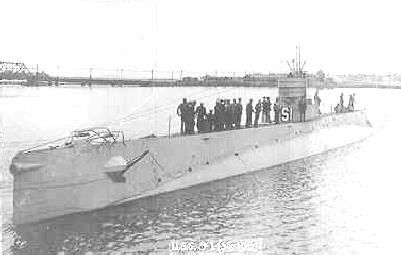
Photo in the private collection of Ric Hedman

Photo courtesy of the Boston Public Library, Leslie Jones Collection. Used with permission.
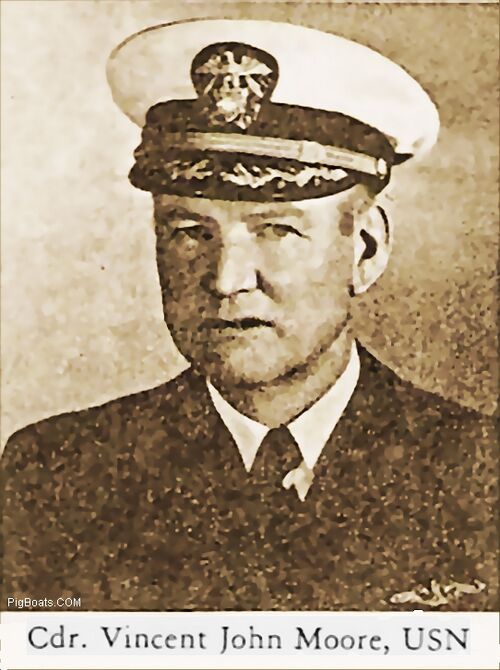
Photo provide by his grandniece, Patricia M. Lynn.
Aircraft operations conversion
Notes

This photo shows the beginning of the conversion work done to S-1 so that she could carry out the Navy's first, and as it turned out only, tests with launching an airplane from a submarine This is at the Portsmouth Navy Yard, Kittery, Maine in the late spring of 1923. The photo shows S-1 alongside the work pier, with O-8 maneuvering into the berth to the left. S-1 has had her aft superstructure removed in preparation to have the watertight aircraft storage cylinder installed. Work is also being done to her forward superstructure to remove the original 3"/23 caliber Mk 9 deck gun. In its place will be a foundation for and installation of a much more substantial 4"/50 caliber Mk 12 Mod 6 gun.
NARA photo via Historylink101.com.
Three different floatplanes were used in the tests. All three were based on a USN Bureau of Aeronautics design and thus were very similar, virtually identical, in appearance. Those types were:
- Cox-Klemin XS-1 - all wood frame with fabric covered fuselage and wings. Powered by a Lawrance L-4 engine. Six were built.
- Cox-Klemin XS-2 - upgraded model with a Kinner B-5 engine. One built.
- Martin MS-1 - License built version with an aluminum frame and fabric fuselage and wings. Six built.
Note how much further down on the pressure hull the newly expanded aft superstructure extended, compared to the first photo above.
In the fourth photo S-1 has flooded down her after ballast tanks, submerging her stern. Note the crewmen walking on her after deck, up to their ankles in water. It appears that S-1 is trying to recover the floatplane after a taxi or flight test.
U.S. Navy and NARA photos via NHHC and Historylink101.com.
These four photos were taken in late 1923 into early 1924 at a cold and snowy Portsmouth Navy Yard and show overhaul work being conducted on the aircraft hangar, perhaps to correct problems revealed in the Norfolk tests. These photos give a good view of how the hangar was arranged.
It was built out of 3/4 inch thick steel and was designed to withstand up to 88 lbs/sq in., or a depth of 197 feet (the test depth of an S-boat was 200 feet). It was 5 ft 9 inches (1.75 meters) in diameter. In case of flooding it was equipped with two separate drain lines and a 100 psi air blow line to empty it. The hemispherical door is hinged on the bottom and sealed to the cylinder by 11 individually bolted flanges. Once unbolted, the heavy door was lowered into a recess in the main deck (normally covered by a slotted deck hatch) using a chain fall attached to the stub mast directly above the door. The aircraft could then be pulled out and assembled for flight.
It proved to take an undesirable amount of time to open the door due to the bolted flanges, and when combined with the time it took to assemble the plane, and with the limited tactical utility of the small and short ranged aircraft, the concept was evaluated as impractical and the testing ended without further development in the USN.
Note the gunboat USS Wilmington (PG-8) moored in the background.
NARA photos via Historylink101.com.
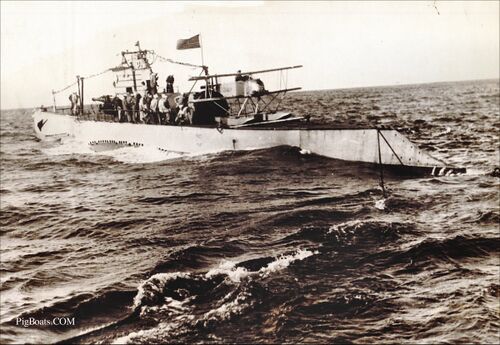
Aircraft testing continued quite slowly between late 1923 and the spring of 1926. It was a conservative testing program, and it may have been slowed by budgetary concerns as well. The first full cycle of surfacing, assembly, launching, retrieving, disassembly, and submergence actually did not take place until July 28, 1926 on the Thames River at New London.
Newspaper Photo Caption: THE FIRST SUBMARINE AIRPLANE IS TESTED OFF NEW LONDON
New London, Connecticut -- The United States Navy held the first tryout of the "Peanut Plane" off New London recently. It is a tiny three cylinder airplane installed in a waterproof casing on the deck of the U.S. submersible S-1 and can be launched in the short time of nine minutes. The plane weighs only 1000 pounds and is flown by the first "Submarine Pilot" LT Dolph C. Allen. Photo shows the plane completely assembled and ready for flight, which is launched by lowering the stern of the submarine. 9-2-26
It should be noted that the launching time of nine minutes was an initial estimate only. In actual practice it turned out to be more like 30-40 minutes in calm weather and good conditions.
News photo in the private collection of Ric Hedman.

Photo in the private collection of Ric Hedman

Photo in the private collection of Ric Hedman
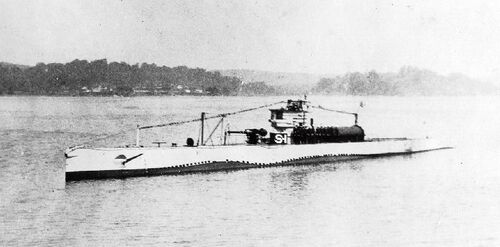
Photo in the private collection of Ric Hedman.
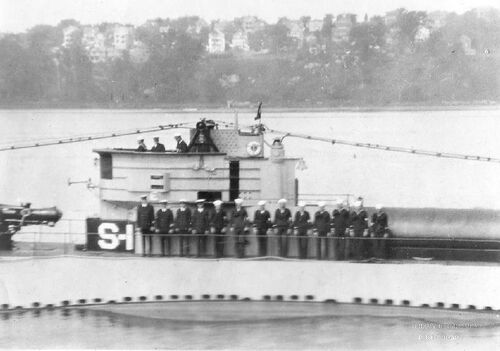
U.S. Navy photo
Photos in the private collection of Ric Hedman
Later operations
Photos in the private collection of Ric Hedman
Page created by:
Ric Hedman & David Johnston
1999 - 2023 - PigBoats.COM©
Mountlake Terrace, WA, Norfolk, VA
webmaster at pigboats dot com









